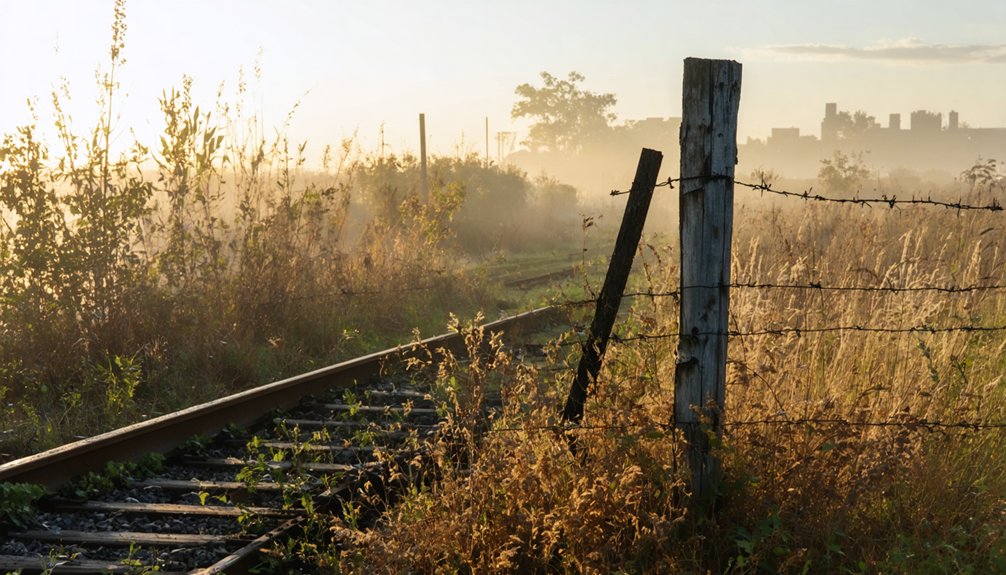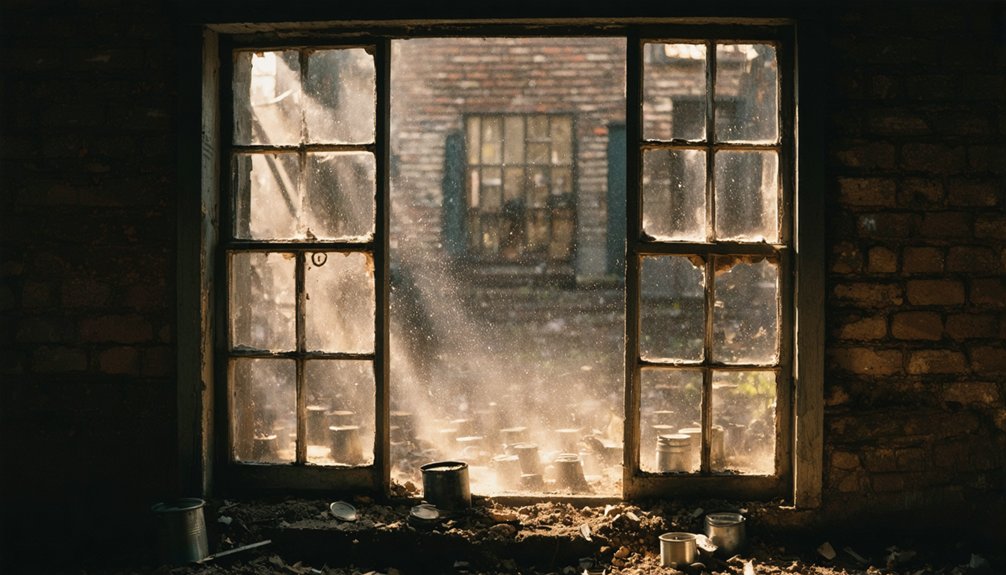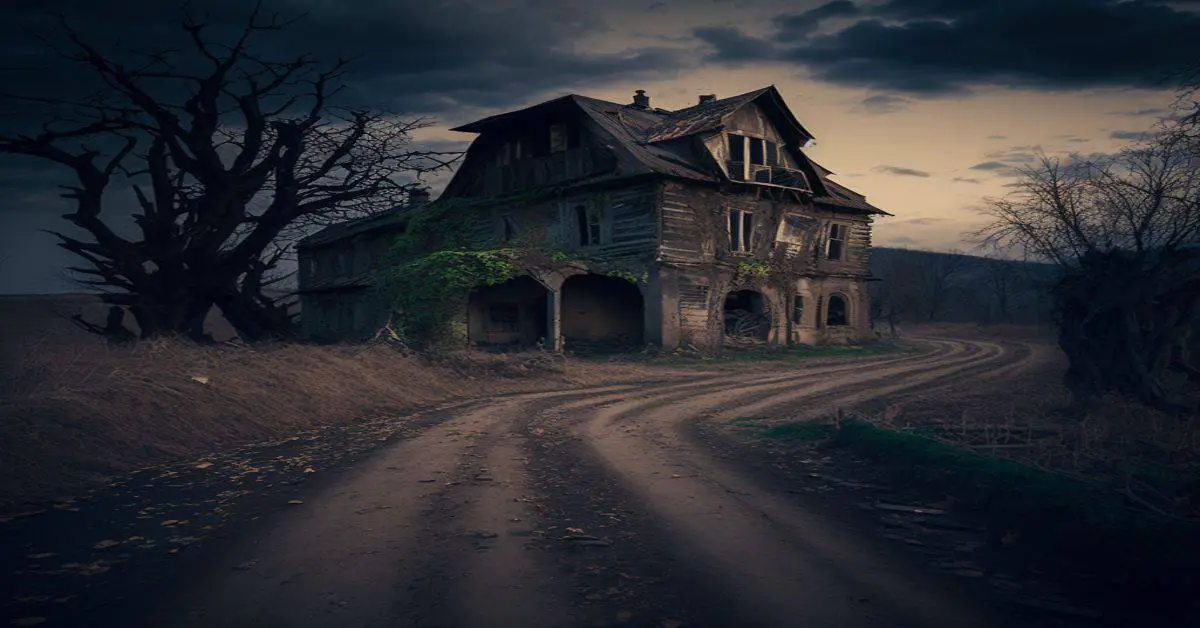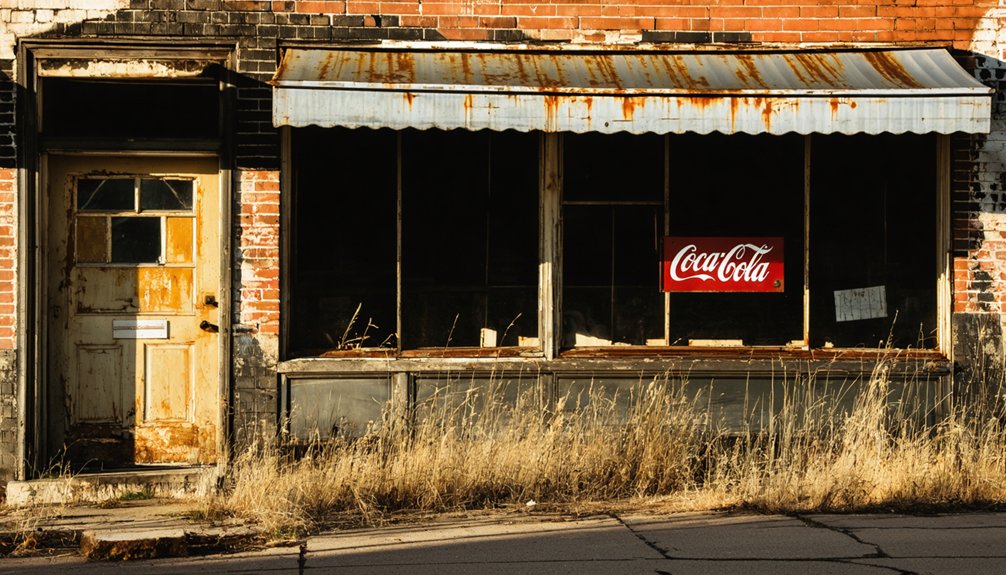You’ll find Morse nestled in Stark County, Illinois at coordinates 41°13′49″N 89°38′42″W, where pioneer families established a thriving agricultural settlement in the early 19th century. John Cryder built the first log cabin, and the community grew with essential infrastructure like shops and schools. Today, only scattered foundation traces remain amid agricultural fields, though archaeological evidence reveals 19th-century pioneer life through glass, metal, and building materials. The ghost town’s legacy tells a broader story of Illinois settlement patterns.
Key Takeaways
- Morse was an early 19th-century agricultural settlement in Stark County, Illinois, located at 41°13′49″N 89°38′42″W.
- Founded by pioneer John Cryder, the settlement centered around subsistence farming, hunting, and fishing activities.
- The town failed to adapt to modernization, leading to population decline and eventual abandonment.
- Few physical remains exist today, with only scattered foundations and the partially preserved James Morse House from 1860.
- The site represents typical patterns of rural Illinois ghost towns, showcasing the rise and decline of agricultural communities.
The Rise and Fall of Morse
While the exact founding date remains unknown, Morse, Illinois emerged as a small agricultural settlement during the early 19th century, likely established by pioneer families seeking opportunities in the fertile Midwestern prairies.
Early settlers faced a landscape filled with forests and boulders left behind from glacial movements.
As you’d expect from early community dynamics, the town gradually developed essential infrastructure, including shops, schools, and possibly a post office to serve its growing population. The development pattern mirrored that of towns like Sangamo Town, which also featured a grist mill, blacksmith, and general store.
Despite its historical significance as an early Illinois settlement, Morse couldn’t sustain itself against the mounting pressures of modernization.
You’ll find this was a common fate for many small towns of the era. The lack of modern amenities, combined with the allure of bigger cities and better opportunities elsewhere, led to a steady exodus of residents.
Today, no structures remain in Morse, and the land has likely returned to its agricultural roots.
Historical Records and Documentation
The historical record of Morse, Illinois survives through a rich collection of primary sources and archival materials.
You’ll find detailed insights about the community through census records from 1900 and 1920, which reveal the demographic makeup and occupations of residents who once called this ghost town home.
Like the First State Bank in Shawnee Town, legal documents chronicle early financial institutions that helped establish commerce in the region.
Similar to other settlements that relied on mineral wealth, the town experienced a period of growth followed by eventual abandonment when resources were depleted.
Court order books from 1847-1855 document land disputes and legal proceedings that shaped the settlement’s development.
The town’s physical layout and evolution can be traced through historic maps of Grundy County and Stark Township, which mark significant features like Indian mounds and cemeteries.
Historic maps of Grundy County reveal the footprint of Morse, documenting its sacred spaces and ancient indigenous sites.
Local newspapers provide additional context through property notices, obituaries, and accounts of events that influenced the town’s decline, while mortality indexes help reconstruct the population’s history through documented lifespans and causes of death.
Life in Early Morse Settlement
As frontier life took root in early Morse, Illinois, John Cryder established the first permanent residence by building a modest log cabin on land previously inhabited by Native American communities.
You’d find settler interactions were limited, with families like the Peacocks joining soon after, creating sparse but self-reliant homesteads across the prairie landscape.
The early settlers faced challenges from local Indian tribes who were being progressively removed from Illinois through various treaties and conflicts.
Daily survival in Morse centered around these key community dynamics:
- Subsistence farming dominated daily life, with settlers adapting to prairie soil conditions.
- Families relied heavily on hunting, fishing, and gathering to supplement their food supplies.
- Mutual aid between neighbors became essential for tasks like barn raising and crop harvesting.
Without formal institutions, you’d experience a life focused on self-sufficiency, where survival skills and cooperation with nearby settlers determined your success in this frontier environment.
Geographic Location and Features
From those early pioneer settlements, Morse developed at precise coordinates 41°13′49″N 89°38′42″W in Stark County, Illinois, where you’ll find it nestled approximately 4 miles north-northwest of Bradford.
The geographic significance of this unincorporated community lies in its position within the fertile Illinois prairie, surrounded by gently rolling farmland that’s dominated by corn and soybean fields. The nearby Waupecan Creek flows about 3 miles from the town’s center.
The rural characteristics of Morse reflect its agricultural heritage, with country roads like 1800 Road providing primary access. Historical records show that early residents used Morse code signals to communicate between distant farms during emergencies.
You’ll notice the community’s integration into the broader Peoria metropolitan area, though it maintains its distinctly rural identity.
The landscape features rich soils shaped by glaciation, creating ideal farming conditions that have defined the region’s economic focus throughout its history.
Exploring What Remains Today
Today you’ll find few physical remnants of Morse, with the site largely reclaimed by agricultural fields and natural vegetation.
If you visit, you might spot scattered foundation traces or degraded infrastructure elements, though most tangible evidence lies beneath the surface awaiting archaeological study.
Historical maps and local records provide your best window into understanding the former town’s layout, as minimal preservation efforts have left the location with few visible landmarks or interpretive markers. Just as in Buda, Illinois, the population has drastically declined over the decades, leaving behind abandoned structures and empty lots.
Physical Site Today
While specific details about Morse’s remaining structures are limited, the ghost town‘s physical site likely mirrors other abandoned Illinois settlements, with deteriorating buildings and nature steadily reclaiming the land.
Much like the dismal river town that Mark Twain once described in nearby Alton, signs of urban decay are evident in any surviving structures, though they may retain fragments of their original architectural significance beneath years of weathering.
If you’re planning to explore the site, you’ll likely encounter:
- Weathered buildings in various states of disrepair, potentially hazardous due to structural instability
- Agricultural fields that have absorbed portions of the former town’s footprint
- Natural overgrowth where vegetation has established new ecosystems, creating wildlife habitats in and around any remaining foundations
Remember that access to the site may be restricted, and you’ll need to respect any private property boundaries or local regulations.
Records and Historical Maps
Tracing Morse’s historical footprint requires careful examination of surviving documents and maps, despite the challenges of limited archival materials.
Through archival research, you’ll find evidence of the town’s existence in county land deeds, township meeting minutes, and early census records. Historical cartography resources, including 19th-century county atlases and USGS quadrangles, can help pinpoint Morse’s original location and track its evolution over time. Similar to Fort Daniel Conservation Area, some ghost town sites are now protected lands that preserve their historical significance.
You can piece together the town’s story through period newspapers, tax assessment rolls, and genealogical records found in local historical societies.
While fires may have destroyed some public archives, digitized databases now offer access to surviving plat maps, business directories, and property transfers that illuminate Morse’s past.
County court records and commissioner documents may reveal additional details about the town’s establishment and eventual decline.
Local Archaeological Evidence
Archaeological investigations at Morse have revealed compelling evidence of 19th-century pioneer life, centered around the partially preserved James Morse House from circa 1860.
You’ll find that careful excavation methods have uncovered local artifacts that tell the story of early settler life, from household ceramics to farming implements.
Key archaeological discoveries include:
- Domestic refuse deposits containing glass, metal items, and personal effects like buttons and smoking pipes
- Building materials and hardware that showcase typical mid-19th-century rural construction techniques
- Evidence of small-scale farming activities in the surrounding landscape
Through meticulous archaeological methods including mechanical and hand digging, soil screening, and spatial mapping, researchers continue to piece together Morse’s role in central Illinois’ rural development.
While prehistoric artifacts are more common in nearby sites, Morse’s remains primarily document the European-American settlement period.
Legacy in Stark County

You’ll find that Morse’s lasting influence on Stark County is preserved through careful documentation in local archives and historical records that chronicle the town’s rise and eventual abandonment.
The ghost town exemplifies broader settlement patterns common to the region, where agricultural communities established roots before facing economic shifts that led to their decline.
As part of Stark County’s historical fabric, Morse’s story illustrates how early Illinois settlements shaped local land use and contributed to the county’s agricultural development.
Historical Records Preservation
While many small Illinois towns have lost their historical records over time, Stark County has maintained an impressive preservation system for documenting its past, including the ghost town of Morse.
You’ll find thorough record preservation efforts through several key organizations working to protect the area’s history:
- The Stark County Genealogical Society maintains essential records at their Toulon facility, including birth, marriage, and death records dating back generations.
- The County Courthouse houses extensive government records from the 1800s, with land records beginning in 1817.
- Advantage Archives has digitized numerous historical materials, including The Stark County News and other local newspapers, making archival practices more accessible.
These preservation initiatives guarantee you can research Morse’s history through both physical and digital collections, safeguarding the community’s legacy for future generations.
Agricultural Community Impact
Throughout the mid-1800s, Morse’s agricultural landscape transformed dramatically as early settlers purchased expansive tracts of 100-160 acres, establishing productive farms on the region’s dark loam prairie soil.
You’ll find evidence of their agricultural innovations in the methodical clearing of timber belts and implementation of advanced crop rotation systems.
By 1950, nearly 900 farms operated in Stark County, generating over $9.3 million in farm product sales.
Farming traditions evolved as families passed down their knowledge through generations, with many operations growing to 262 acres.
The region’s success relied heavily on tenant farmers, who operated 43% of local farms, while railroad connections enabled broader market access.
The community’s agricultural legacy lives on through the preserved farmlands that once supported this thriving rural economy.
Local Settlement Patterns
As indigenous Sac tribes were forcibly relocated west of the Mississippi in the 1830s, Euro-American pioneers began establishing permanent settlements across Stark County’s untamed prairie landscape.
Early settler interactions were shaped by isolation and the challenges of frontier life, with families relying heavily on kinship networks for survival.
Key patterns that emerged in Morse’s early development:
- Scattered homesteads dominated the region rather than concentrated villages, reflecting the agricultural focus of pioneer life.
- Religious gatherings and communal work events became essential social bonds in the sparsely populated area.
- The shift from log cabins to brick structures by 1842 marked a change toward permanent settlement.
While indigenous influences were minimal after removal, the legacy of Sac presence contributed to settler anxieties during initial colonization efforts.
Research and Archaeological Findings

Despite extensive archaeological studies across Illinois, research specific to the ghost town of Morse remains limited.
While archaeological methodologies commonly used in Illinois sites involve systematic excavation and artifact analysis, there’s no evidence of formal investigations in Morse. You’ll find that nearby locations, such as Cahokia and the East St. Louis Mound Precinct, have received considerably more attention from researchers.
The cultural significance of the region is primarily tied to the broader Mississippian culture, which dominated much of Illinois through its complex societies and earthwork mounds.
While modern digital tools and data recovery techniques could potentially reveal more about Morse’s history, no thorough archaeological surveys have been conducted. The site’s documentation appears to be minimal compared to other Illinois ghost towns listed in the National Register of Historic Places.
Frequently Asked Questions
Were There Any Notable Crimes or Incidents Reported in Morse’s History?
Like a dusty page torn from history, there aren’t any confirmed crimes or unsolved mysteries from Morse’s past. Local legends might exist, but you won’t find documented incidents in historical records.
What Was the Peak Population of Morse Before Its Decline?
You won’t find exact peak population records, but given typical population growth patterns and decline factors of similar Illinois ghost towns, it likely peaked at several hundred residents in the late 1800s.
Did Any Famous People or Important Figures Come From Morse?
You might be disappointed, but there’s no record of any famous residents or historically significant figures from this forgotten settlement. The passage of time has erased most personal histories.
What Businesses or Industries Operated in Morse During Its Existence?
You’d find grain storage facilities, agricultural services, and blacksmith shops thrived alongside the railroad. Local businesses included brick yards, hardware stores, and hotels serving farmers and canal workers.
Were There Any Schools, Churches, or Community Buildings in Morse?
While you’d expect schools and churches to anchor small-town life, historical records don’t provide concrete evidence of any school history or church significance in this particular location’s community buildings.
References
- https://www.youtube.com/watch?v=93k0qtvzkn4&vl=en-US
- https://grundy-ilgw.genealogyvillage.com/history/morristwp.php
- https://www.heraldtimesonline.com/story/lifestyle/home-garden/2021/01/15/some-illinois-ghost-towns/43846097/
- https://www.youtube.com/watch?v=BW9–q72bn0
- https://en.wikipedia.org/wiki/List_of_ghost_towns_in_Illinois
- https://www.youtube.com/watch?v=lfj6aeZEVJY
- https://stephenjessetaylor.wordpress.com/tag/ghost-towns/
- https://www.youtube.com/watch?v=fy3yJDBA5nI
- https://freepages.rootsweb.com/~gtusa/history/usa/il.htm
- https://www.wcihs.org/library/



